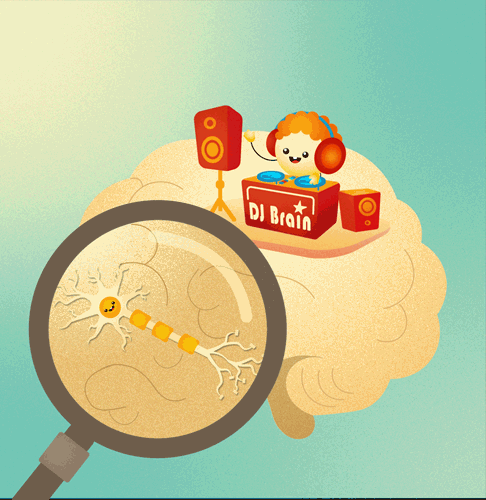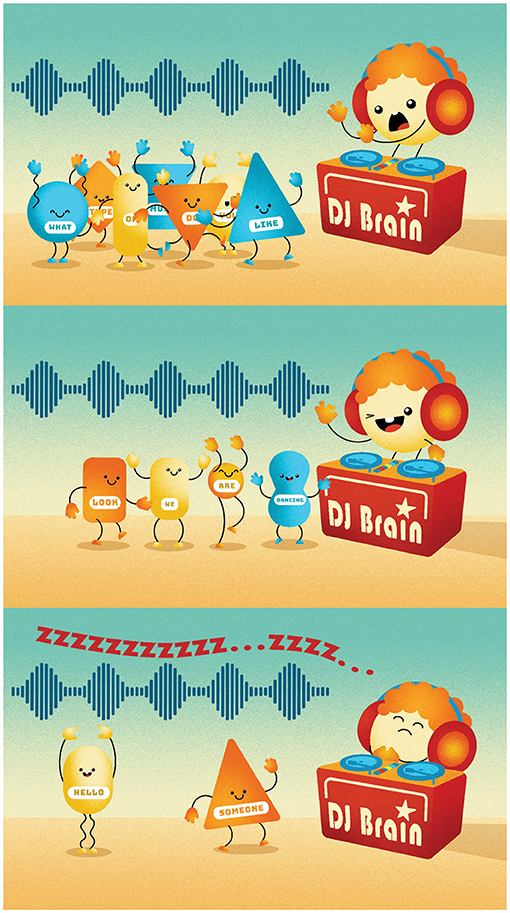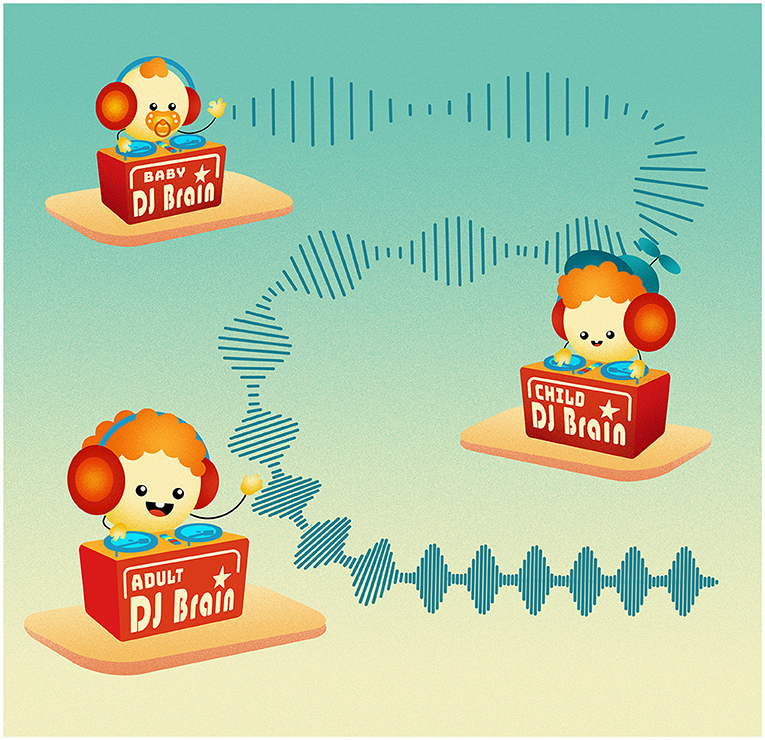Abstract
The human brain is made of many cells called neurons, responsible for processing information. Neurons work in rhythms, setting the pace for language. Like a DJ playing music to set the pace for dancing, the brain’s DJ determines how quickly we can pick up words. If someone speaks too fast, the words “dance” faster than the DJ’s favorite rhythm. If someone speaks too slowly, words “dance” too slowly and lag behind the DJ. The brain contains multiple rhythms, so we could say that there are multiple DJs. This is important for understanding language, because not everything at the language party happens at the speed of words. Some DJs play rhythms that are perfect for catching the quick sounds that make up words. Others play a slow groove to help us grasp entire sentences. In this way, our brain cells are like DJs throwing a party for language.
Have you ever wondered how you can understand all the different sights, smells, and sounds in the world around you? This is made possible by the extraordinary ability of your brain to shape your perception of the world. This article will look at the particular case of how the brain processes language. Language is one of the most important things your brain can understand, because it helps you to communicate with other people.
Your first language—the one you learned when you were very little—feels easy for you to understand, even if people say a lot in a short time. How can the brain sort out all this information? Imagine there is something in your brain like a DJ at a party. A party can be quite a whirlwind of activity! The DJ plays music to make the audience move together—on every beat of the music, the dancers can make a dance move. Through music, a DJ can control the action on the dance floor, such as the speed at which the dancers move.
Your brain also has a special DJ, in charge of the biggest whirlwind of a party ever—your perception of the world! Your brain’s DJ works similarly to a DJ playing music, by setting the speed at which information is processed. Imagine you are listening to someone speaking. Your job as a listener is to understand each word. Every beat that your brain’s DJ plays is an opportunity to catch a word. But why is it so important that the brain’s DJ sets the rhythm, and how exactly does that work?
The DJ Creates the Beats: The Brain Follows a Rhythm
The human brain is a network of over 80 billion nerve cells called neurons. The activity of these neurons is important for understanding everything in the outside world, including information coming through the ears (such as music or speech), the eyes (such as your favorite color), or the nose (such as the smell of your dinner).
A neuron cannot process new information all the time, because it needs time to rest after processing some information. Once the neuron has recovered, it is ready to receive new information again. This leads to a repetitive pattern of neuronal activity and rest, which makes brain activity rhythmic. Scientists call these brain rhythms neural oscillations.
You can imagine these rhythms as regular beats in music (Figure 1). When a DJ plays music at a party, there are regular pauses between the beats in the song. The rhythm of the beats guides the timing of dance moves. Similarly, the rhythm of the brain helps us understand language by setting the pace for processing pieces of information, such as words or sentences [1].

- Figure 1 - The brain’s DJ sets a rhythm.
- This rhythm results from repeating patterns of activity and recovery of neurons in the brain.
The DJ Sets the Speed: Brain Rhythms as Pacemaker for Language Processing
One important idea in neuroscience is that the activity inside the brain influences how we perceive the outside world. This is called the inside-out perspective [2]. In our example, the DJ only likes to play a certain beat. People at the party should dance to these beats. Similarly, the brain likes a certain speed and cannot work at any possible pace. In this way, brain rhythms act as a pacemaker for how fast the brain can process language. As we mentioned earlier, brain rhythms set the pace for when neurons are active and when they are at rest. This means that each beat played by the brain’s DJ inside the brain is a chance for you to catch a piece of information from the outside, for example a word you hear.
When you listen to someone speaking, there are limits to the speed at which you can understand the speaker. If you watch a YouTube video and set the playback speed to twice the original, you will struggle to understand the story. If someone speaks quicker than the rhythm of your brain, too many words arrive in too little time, and your brain might miss some words. Think of dancing faster than the beat of a song. In contrast, if someone speaks slower than what your brain’s DJ allows, you might lose track of what is being said. Imagine if someone tried to dance a slow waltz to the fast music that you usually hear at a party—that would not match. Figure 2 shows what happens when the words do not come in at the speed the DJ prefers. Can you see which speed the DJ likes the most?

- Figure 2 - The brain’s DJ sets the speed for language processing.
- The DJ only likes to play a certain beat. Words need to arrive with the beats of the DJ—they should not arrive too quickly or too slowly, but must have just the right speed. When the words do not match the DJ’s beats, we have trouble processing them.
Here is the fun part: there is not one, but many rhythms in the brain! This is as if there were many DJs at the party, each of them playing their own beats. Multiple rhythms are important for understanding language, because not everything in language happens at the speed of words. For instance, there can be more than one syllable within a single word and more than a single word in a sentence. So, the brain needs a whole lineup of DJs to keep track of all these beats simultaneously. Besides the DJ that collects the individual words, there are slower and faster rhythms. In music, there is a fast beat that supplies the individual tones and a slower melody that combines the tones into a song. Similarly, in language, a faster rhythm helps us catch the quick sounds that make up words. At the same time, a slower rhythm helps us combine the different words into sentences.
The DJ Does the Mix: Brain Rhythms in Action
But how do these brain rhythms influence our behavior and language comprehension in real life? Let us consider reading a book. The text is written out on a page, one word following another. Some words are longer and other words may be shorter, but the text on the paper does not require us to read at a specific speed. Try it out: first read this sentence really quickly and then really slowly. You might notice that there is a limit to how fast you can read the sentence while still understanding it, similar to watching a YouTube video at twice the speed. Also, if you read really slowly, you may forget the beginning of the sentence before reaching the end. Interestingly, researchers have found that our eyes follow specific rhythms while reading [3]. One rhythm reflects the speed at which our eyes move from one word to the next. This rhythm may be perfect for catching the words. The other rhythm is much slower and can help us combine the words into sentences. Since there is nothing on the outside that requires us to read at a specific speed, the activity inside the brain may influence how fast we read. Indeed, we found that the rhythms of our eyes align to the rhythms in the brain. This is one example of the inside-out perspective.
From Baby DJ to Adult DJ: Brain Rhythms Change as we Age
Do your parents have the same brain rhythms as you? No! The DJ in the child brain plays different beats than the one in the adult brain (Figure 3). Directly after birth, the baby DJ likes a slow groove. As a child grows up, the DJ in their brain also starts to like faster songs. According to the inside-out perspective in neuroscience, the slow activity inside the baby’s brain should affect how the baby processes information in the outside world. Babies should be much better at processing language when people speak more slowly. Indeed, we see this in the way we speak to babies.

- Figure 3 - Brain rhythms change as we age.
- The baby brain DJ is really slow and becomes faster with age.
Have you ever spoken to a baby? You may have noticed that you speak a little differently—your voice gets higher, and you speak more slowly. Although this may seem a bit silly, it fits exactly with the rhythms of the baby brain. Babies process language better when people speak to them in this special way [4]. Returning to our example, it is as if the dancers need to adjust their dancing speed to match the slower tunes of the DJ in the baby brain. If they move at the right speed, their dance moves will fit into the slow beats of the song the DJ is playing—just like we speak at a slower speed to the baby.
What Did You Learn?
By thinking of groups of neurons in your brain as a DJ mixing the party of your language comprehension, it is easy to see how important the speed and rhythm of brain activity are. Just like a DJ provides just the right beat for the dancers to get groovy, your brain rhythms play a crucial role in how you process and understand the world around you.
Glossary
Rhythm: ↑ A pattern of sounds or movements that repeat in a regular sequence. Rhythm can be found in music, dancing, or even in our speech.
Neurons: ↑ Brain cells that have a special function: transmitting information. Neurons send and receive signals about our thoughts, feelings, and senses like sight, sound, or smell.
Brain Rhythms: ↑ Also called neural oscillations. Repetitive patterns of activity in the brain. These rhythms help organize the brain’s processing and help language comprehension.
Neuroscience: ↑ The scientific study of the structure and function of the brain.
Inside-out Perspective: ↑ A theory in neuroscience that activity inside the brain influences the perception of the outside world.
Pacemaker: ↑ Something that keeps a steady beat or rhythm. An example is a metronome in music, which sets the speed for others to follow.
Conflict of Interest
The authors declare that the research was conducted in the absence of any commercial or financial relationships that could be construed as a potential conflict of interest.
Acknowledgments
Funding was provided by the Max Planck society to the Max Planck Research Group Language Cycles.
AI tool Statement
The author(s) declare that no Gen AI was used in the creation of this manuscript.
Any alternative text (alt text) provided alongside figures in this article has been generated by Frontiers with the support of artificial intelligence and reasonable efforts have been made to ensure accuracy, including review by the authors wherever possible. If you identify any issues, please contact us.
References
[1] ↑ Meyer, L., Sun, Y., and Martin, A. E. 2020. Synchronous, but not entrained: exogenous and endogenous cortical rhythms of speech and language processing. Lang. Cogn. Neurosci. 35:1089–99. doi: 10.1080/23273798.2019.1693050
[2] ↑ Buzsáki, G. 2019. The Brain from Inside Out. New York, NY: Oxford University Press, 441.
[3] ↑ Henke, L., Lewis, A. G., and Meyer, L. 2023. Fast and slow rhythms of naturalistic reading revealed by combined eye-tracking and electroencephalography. J Neurosci. 43:4461–9. doi: 10.1523/JNEUROSCI.1849-22.2023
[4] ↑ Menn, K. H., Michel, C., Meyer, L., Hoehl, S., and Männel, C. 2022. Natural infant-directed speech facilitates neural tracking of prosody. NeuroImage 251:118991. doi: 10.1016/j.neuroimage.2022.118991
